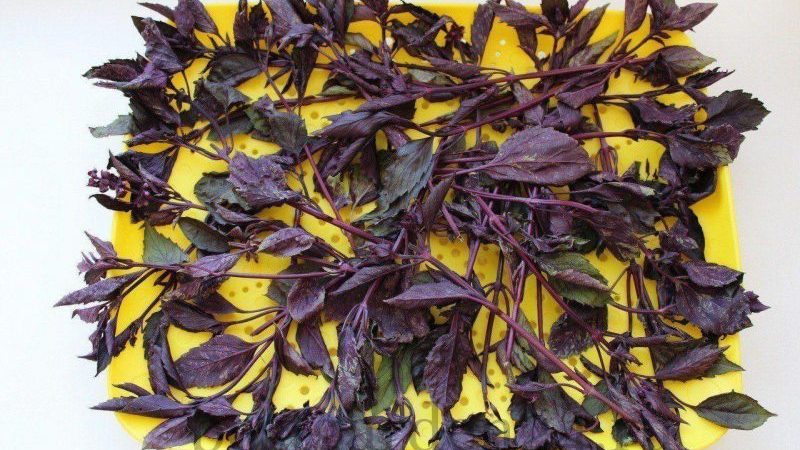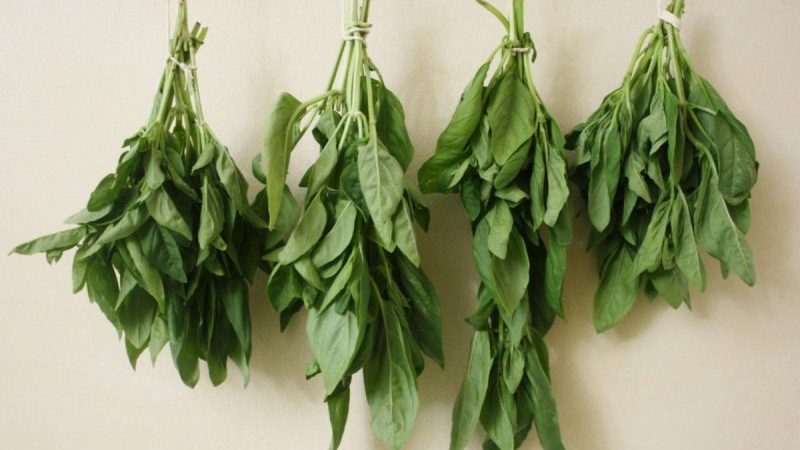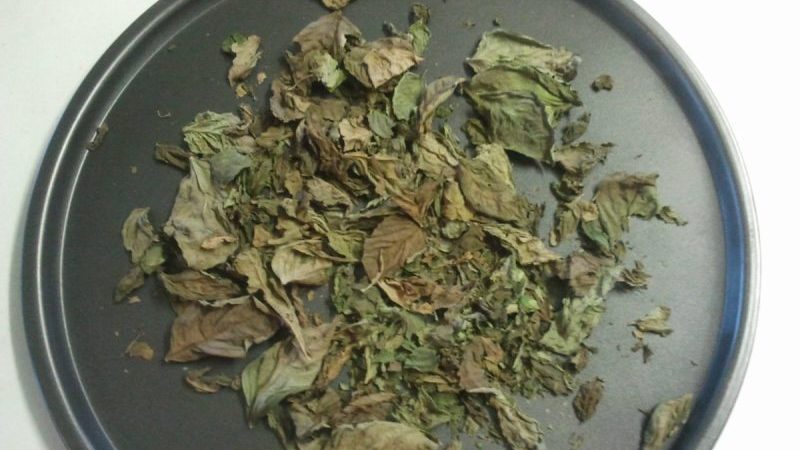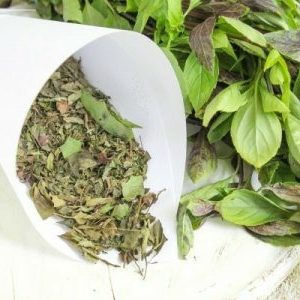When to collect and how to properly dry basil at home
Basil is an annual herb that is used in medicine, cooking and cosmetology. It is suitable as a seasoning in soups and salads, retains a pronounced aroma in frozen and dried. Basil is used to flavor vinegar and vegetable oil. How to dry basil at home - we will tell you in the article.
The content of the article
Can basil be dried
Using fresh herbs all year round is a difficult task, it is not always possible to purchase them in winter. In this case, the solution to the problem is to prepare dried herbs at home. Basil is dried in several ways. In the process, take into account that the plant should not be exposed to direct sunlight - in this case, it will lose its entire supply of vitamin C.
Important! Basil should not be used by people with coronary heart disease, thrombophlebitis, hypertension, who have had myocardial infarction.

Advantages and disadvantages of this procurement method
A significant advantage of this method is that a properly dried plant retains a rich chemical composition:
- vitamins A, C, K, E;
- manganese;
- iron;
- zinc;
- copper;
- phosphorus;
- selenium;
- glycosides and saponins;
- essential oils;
- tannins;
- phytoncides and sugars.
Useful properties of dried basil:
- replenishment of missing vitamins during diets - strict diets lead to a deficiency of nutrients, and fresh or dried basil makes up for their lack;
- cleansing the body - the plant helps to remove toxins from the body;
- antiseptic and anti-inflammatory properties - the plant relieves influenza, improves the functioning of the gastrointestinal tract, soothes toothache and relieves inflammation of the larynx and genitals.
- dried herbs stimulate the brain and calm the nervous system.
The disadvantages of drying are of a technical nature:
- you will need special equipment - a microwave oven, an electric dryer, etc.;
- will have to take care of the place where be kept greens before drying - it should be dry, dark and ventilated.
Selecting and preparing basil for drying
Leaves are used as raw materials, excluding sticks, since they are rough, or flowers - depending on the taste preferences of the cook.
The collected raw materials are sorted out, washed with running water. Wet herbs are not used for drying, so the basil is shaken off, and then laid out on a towel or paper in one layer. In this form, the plants are left in a dry and dark place until all the moisture has evaporated.
Important! Cannot be dried basil on the newspaper, as the printing ink is poisonous and absorbed by the plant.
When to collect it to dry for the winter
Basil is cut during the summer before or during flowering... At this moment, the flower contains the largest amount of trace elements (zinc, copper, manganese, sodium) and aromatic substances, and the stems have not yet become coarse.
The crop is harvested twice - in July and at the end of September. It is better to pluck the leaves on a dry sunny morning - at this time they are sufficiently dried.
Important! Air circulation, shade and warmth are essential for proper drying.
Basil drying methods
If there are no special devices, choose one of the natural drying methods.
In bundles
For drying, young twigs with 8-12 leaves are cut in bunches. The stalks are washed with water, dried and tied into bundles of no more than 7 pcs. - this way the plants will dry out faster.
Finished bundles are hung on a rope at a distance of 15-20 cm from each other in a dry, darkened and well-ventilated place. For this purpose, a barn, an attic, a balcony are suitable. After 2-3 weeks, the basil will be ready.

Sheets
This method requires freshly cut basil leaves. Algorithm of actions:
- Wash and dry the leaves.
- Line a baking sheet with paper (you can use window screens instead).
- Arrange the leaves in 1 layer.
- To protect greenery from dust and insects, cover the workpiece with nylon mesh or gauze. Ordinary fabric cannot be used, as its dense structure will disrupt air permeability, and then the basil will rot and become unusable.
- Place the baking sheet in a dark and ventilated place.
- After 2 weeks, arrange the dry leaves in convenient containers, close them tightly with lids and store them.
Crushed

This method differs from the previous one in that all the prepared raw materials are crushed, and an oven is used as an auxiliary device.
How to proceed:
- Rinse and dry the basil.
- Chop the leaves, but not too finely.
- Cover a baking sheet with baking paper, put chopped plants on it in a thin layer.
- Heat the oven to + 40 ° C and place a baking sheet.
- Dry the spice for 4-6 hours, while every two hours open the oven door, leaving a small gap for 20-30 minutes.
- After drying, give blank cool, and then put in convenient containers and leave for storage.
How to dry outdoors
When drying basil in the open air, take into account the disadvantages of this method:
- humidity and ambient temperature affect the drying time - the process can take several days or weeks;
- dirt and dust settle on the blanks if they are not protected by anything;
- in the open air, essential oils evaporate from herbs, which makes the aroma of the dried product weaker;
- when exposed to direct sunlight, the color of the basil fades.
The spice is dried outdoors in any convenient way: bunches or leaves. Optimum conditions are air temperature + 22 ... + 24 ° С, humidity 60-70% and absence of direct sunlight.
In the oven
Before drying the herbs, they are washed and dried. To do this, the leaves are laid out on a cotton towel so that it absorbs moisture. Change the towel as needed. After 3-4 hours, start the drying procedure.
Algorithm of actions:
- Preheat the oven to + 100 ° C.
- Place parchment paper on a baking sheet, and basil leaves on top with a thin layer.
- Do not close the oven for 2 hours. The leaves will decrease several times, but their aroma will increase.
In the microwave
The main advantage of microwave drying is that the desired result is obtained in a matter of minutes.
List of actions:
- Collect raw materials, rinse and dry.
- Place a napkin on a plate.
- Top with basil leaves in one layer.
- Turn on the microwave for 600-800 W.
- Wait 3-4 minutes.
After that, the dried herb is sent for storage or immediately added to dishes.
In an electric dryer
In order to dry the basil in this way, the following algorithm is followed:
- Rinse the collected leaves, shake off, leave to dry.
- Put the grass on a pallet in one layer.
- Set the temperature to + 35 ° С.
- Replace pallets every hour.
Dried basil is ready in 4 hours.
How to check readiness
Properly dried basil breaks down and crumbles well, has a noticeable smell and a rich color - dark green or purple.
How and where to apply

Basil gruel is used to make face and hair masks. Such products relieve inflammation, rejuvenate and tone the skin.
Dried basil is added as a spice to minced meat, sauces, hot and cold dishes. The universal spice improves the taste of meat and fish.Dried greens replace fresh herbs in canning and pickling.
Some varieties have a lemon scent and are suitable for brewing tea. In folk medicine, this tea is used to treat diseases of the nervous system, increased fatigue. Broths are drunk for kidney diseases, respiratory diseases.
How to eat
Dried basil, in a chopped form, is added to the finished dish, for example, in a soup or salad. Also, the seasoning is used instead of pepper in the manufacture of sausage and smoked meat products.
Important! The spice is contraindicated for people with allergies, diabetes and cardiovascular diseases. Pregnant women use it in limited quantities.
How to store dried basil
The whole leaves are folded into paper bags, covered and stored in a dark, dry place. Ground basil is poured into sealed jars with tight lids. It is important that they do not let the air in, as the aroma of basil wears out quickly.
If all drying conditions have been met, then the spice is stored for a year.
Conclusion
To prepare the seasoning, auxiliary devices are useful: a microwave oven, an electric dryer or an oven. If conditions permit, dry naturally in the open air. Dried basil is stored in bunches or ground in containers that do not allow air to pass through.